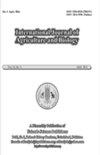化学改良对不同盐碱条件下水稻生理化学反应的影响
Q2 Agricultural and Biological Sciences
引用次数: 4
摘要
盐度和碱度是干旱和半干旱地区主要的非生物限制因素。要有效利用这片土地,必须妥善管理。碱土和盐碱土的开垦具有高度的场地特异性,描述了不同土壤对不同改良剂的不同反应。这些开垦的做法也改变了植物的生理和离子特性。本试验旨在更好地了解水稻作物在不同盐/钠水平下的生理和离子响应。以ECe (dS m-1):SAR (mmol L-1)1/2水平分别为4:20、8:40、12:60和16:80的土壤进行了渗滤试验,各水平分别用有机肥(25 Mg ha-1)和无机(100%土壤石膏需取量(SGR)的石膏和相当于100% SGR的硫酸)改进剂处理,对照组不加任何改进剂。结果表明,施硫酸后施石膏对水稻生理性状(光合速率、蒸腾速率、气孔导度和总叶绿素含量)、离子含量(氮、钾和钾钠比)和生长的相对增幅最大。与对照相比,施用硫酸的生物产量、株高和水稻产量平均分别提高25%、31%和45%。结果表明,硫酸和石膏都是盐碱度较低土壤复垦的最佳改良剂,而在盐碱度较高的土壤中,只有硫酸对水稻增产效果较好。©2021朋友科学出版社本文章由计算机程序翻译,如有差异,请以英文原文为准。
Effect of Chemical Reclamation on the Physiological and Chemical Response of Rice Grown in Varying Salinity and Sodicity Conditions
Salinity and sodicity are the major abiotic constraints that prevail in arid and semi-arid regions. Proper management is required for productive use of this land. Reclamation of sodic and saline-sodic soils is highly site-specific that describes the diverse response of different soils to different amendments. These reclamation practices also alter the plant's physiological and ionic characteristics. This experiment aimed to better understand the physiological and ionic responses of rice crop at different salinity/sodicity levels. A lysimeter experiment was set forth with soil having ECe (dS m-1):SAR (mmol L-1)1/2 levels as 4:20, 8:40, 12:60 and 16:80 and all the levels were treated with organic (farm manure at 25 Mg ha-1) and inorganic (gypsum at 100% soil gypsum requirement (SGR) and sulphuric acid equivalent to 100% SGR) amendments keeping no ammendment as control. Results revealed that the maximum relative increase in physiological attributes (photosynthetic rate, transpiration rate, stomatal conductance and total chlorophyll contents), ionic contents (nitrogen, potassium and K:Na ratio) and growth of rice were recorded with sulphuric acid application followed by gypsum. On an average 25%, 31% and 45% increase in biological yield, plant height and paddy yield, respectively was observed with sulphuric acid application over control. It is concluded that sulphuric acid and gypsum both were the best amendments for reclamation of soil having a low level of salinity/sodicity whereas, at higher salinity/sodicity levels, only sulphuric acid seemed better for improved rice production. © 2021 Friends Science Publishers
求助全文
通过发布文献求助,成功后即可免费获取论文全文。
去求助
来源期刊

International Journal of Agriculture and Biology
AGRICULTURE, MULTIDISCIPLINARY-
CiteScore
1.70
自引率
0.00%
发文量
40
审稿时长
5 months
期刊介绍:
Information not localized
 求助内容:
求助内容: 应助结果提醒方式:
应助结果提醒方式:


